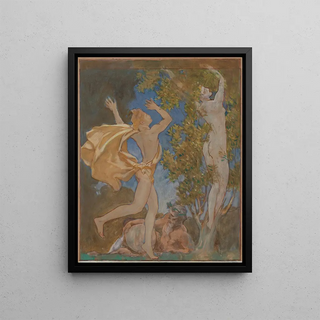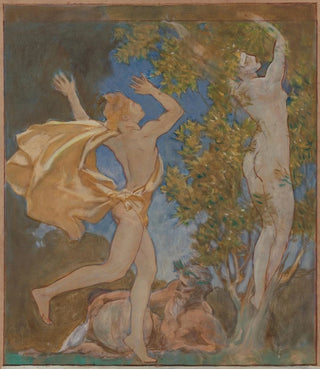Art print | Apollo and Daphne - John Singer Sargent


View from behind

Frame (optional)
Apollon and Daphné - John Singer Sargent – Captivating Introduction
The artwork "Apollon and Daphné" by John Singer Sargent is a striking illustration of classical mythology, where drama and beauty converge in a ballet of colors and shapes. This painting evokes a timeless story, that of Apollon, the god of light, and Daphné, the nymph seeking to escape her destiny. This piece, far more than a simple representation, is an exploration of love, transformation, and human passions. The art print Apollon and Daphné - John Singer Sargent allows you to immerse yourself in this fiery universe, where every detail tells a story and emotions resonate through the canvas.
Style and uniqueness of the work
Sargent's technical mastery is evident in every brushstroke, revealing a style that combines realism and impressionism. The dynamic composition, where Daphné transforms into laurel, illustrates not only the narrative tension but also the virtuosity of the artist. The drapery of the clothing, the movement of the bodies, and the expression of the faces are all elements that captivate the viewer and invite them to feel the intensity of this frozen moment in time. The color palette chosen by Sargent, oscillating between warm hues and cool shades, enhances the contrast between Apollon’s passion and Daphné’s flight, creating an atmosphere that is both tragic and enchanting. This work is a true masterpiece that transcends mere decoration to become a living dialogue between art and viewer.
The artist and his influence
John Singer Sargent, born in 1856, is often regarded as one of the greatest portraitists of his era. His ability to capture the personality and essence of his subjects, whether aristocrats or everyday figures, marked his time and continues to influence contemporary artists. Sargent successfully integrated elements of European tradition while embracing innovations of the early 20th century. His interest in light and color, along with his bold approach to composition, makes him an indispensable figure in the

Matte finish

View from behind

Frame (optional)
Apollon and Daphné - John Singer Sargent – Captivating Introduction
The artwork "Apollon and Daphné" by John Singer Sargent is a striking illustration of classical mythology, where drama and beauty converge in a ballet of colors and shapes. This painting evokes a timeless story, that of Apollon, the god of light, and Daphné, the nymph seeking to escape her destiny. This piece, far more than a simple representation, is an exploration of love, transformation, and human passions. The art print Apollon and Daphné - John Singer Sargent allows you to immerse yourself in this fiery universe, where every detail tells a story and emotions resonate through the canvas.
Style and uniqueness of the work
Sargent's technical mastery is evident in every brushstroke, revealing a style that combines realism and impressionism. The dynamic composition, where Daphné transforms into laurel, illustrates not only the narrative tension but also the virtuosity of the artist. The drapery of the clothing, the movement of the bodies, and the expression of the faces are all elements that captivate the viewer and invite them to feel the intensity of this frozen moment in time. The color palette chosen by Sargent, oscillating between warm hues and cool shades, enhances the contrast between Apollon’s passion and Daphné’s flight, creating an atmosphere that is both tragic and enchanting. This work is a true masterpiece that transcends mere decoration to become a living dialogue between art and viewer.
The artist and his influence
John Singer Sargent, born in 1856, is often regarded as one of the greatest portraitists of his era. His ability to capture the personality and essence of his subjects, whether aristocrats or everyday figures, marked his time and continues to influence contemporary artists. Sargent successfully integrated elements of European tradition while embracing innovations of the early 20th century. His interest in light and color, along with his bold approach to composition, makes him an indispensable figure in the






